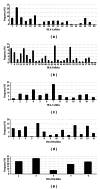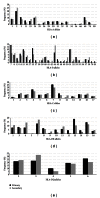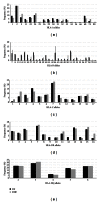HLA-B∗44 Is Associated with Dengue Severity Caused by DENV-3 in a Brazilian Population
- PMID: 23818909
- PMCID: PMC3684019
- DOI: 10.1155/2013/648475
HLA-B∗44 Is Associated with Dengue Severity Caused by DENV-3 in a Brazilian Population
Abstract
Human leukocyte antigen (HLA) alleles have been correlated with susceptibility or resistance to severe dengue; however, few immunogenetic studies have been performed in Latin American (LA) populations. We have conducted immunogenetic studies of HLA class I and II alleles in a cohort of 187 patients with DENV-3 infection and confirmed clinical diagnosis of either severe dengue, known as dengue hemorrhagic fever (DHF), or the less severe form, dengue fever (DF), in Recife, Pernambuco, Brazil. An association analysis was performed using Fisher's association test, with odds ratios (ORs) calculated using conditional maximum likelihood estimates. HLA-B∗44 (P = 0.047, OR = 2.025, 95% CI = 0.97-4.24) was found to be associated with increased susceptibility to DHF in response to DENV-3 infection. In addition, HLA-B∗07 (P = 0.048, OR = 0.501, one-sided 95% CI = 0-0.99) and HLA-DR∗13 (P = 0.028, OR = 0.511, one-sided 95% CI = 0-0.91) were found to be associated with resistance to secondary dengue infection by DENV-3. These results suggest that HLA-B∗44 supertype alleles and their respective T-cell responses might be involved in susceptibility to severe dengue infections, whereas the HLA-B∗07 supertype alleles and DR∗13 might be involved in cross-dengue serotype immunity.
Figures



Similar articles
-
Major Histocompatibility Complex Class I and Dengue Hemorrhagic Fever: A Meta-Analysis of Human Leukocyte Antigens A*24 and B*44.Cureus. 2022 Nov 14;14(11):e31485. doi: 10.7759/cureus.31485. eCollection 2022 Nov. Cureus. 2022. PMID: 36532922 Free PMC article.
-
HLA-A and -B allele associations with secondary dengue virus infections correlate with disease severity and the infecting viral serotype in ethnic Thais.Tissue Antigens. 2002 Oct;60(4):309-18. doi: 10.1034/j.1399-0039.2002.600405.x. Tissue Antigens. 2002. PMID: 12472660
-
Susceptible and protective HLA class 1 alleles against dengue fever and dengue hemorrhagic fever patients in a Malaysian population.PLoS One. 2010 Sep 28;5(9):e13029. doi: 10.1371/journal.pone.0013029. PLoS One. 2010. PMID: 20927388 Free PMC article.
-
HLA and other gene associations with dengue disease severity.Curr Top Microbiol Immunol. 2010;338:99-114. doi: 10.1007/978-3-642-02215-9_8. Curr Top Microbiol Immunol. 2010. PMID: 19802581 Review.
-
Dengue and dengue haemorrhagic fever: implications of host genetics.FEMS Immunol Med Microbiol. 2006 Jul;47(2):155-66. doi: 10.1111/j.1574-695X.2006.00058.x. FEMS Immunol Med Microbiol. 2006. PMID: 16831202 Review.
Cited by
-
Complement factor H gene (CFH) polymorphisms C-257T, G257A and haplotypes are associated with protection against severe dengue phenotype, possible related with high CFH expression.Hum Immunol. 2013 Sep;74(9):1225-30. doi: 10.1016/j.humimm.2013.05.005. Epub 2013 Jun 6. Hum Immunol. 2013. PMID: 23747994 Free PMC article.
-
HLA alleles and dengue susceptibility across populations in the era of climate change: a comprehensive review.Front Immunol. 2025 Apr 15;16:1473475. doi: 10.3389/fimmu.2025.1473475. eCollection 2025. Front Immunol. 2025. PMID: 40303409 Free PMC article. Review.
-
Genome-Wide Analysis to Identify HLA Factors Potentially Associated With Severe Dengue.Front Immunol. 2018 Apr 10;9:728. doi: 10.3389/fimmu.2018.00728. eCollection 2018. Front Immunol. 2018. PMID: 29692780 Free PMC article.
-
Development of Peptide Vaccines in Dengue.Curr Pharm Des. 2018;24(11):1157-1173. doi: 10.2174/1381612823666170913163904. Curr Pharm Des. 2018. PMID: 28914200 Free PMC article. Review.
-
Uncovering the Burden of Dengue in Africa: Considerations on Magnitude, Misdiagnosis, and Ancestry.Viruses. 2022 Jan 25;14(2):233. doi: 10.3390/v14020233. Viruses. 2022. PMID: 35215827 Free PMC article. Review.
References
-
- Halstead SB. Pathogenisis of dengue: challenges to molecular biology. Science. 1988;239(4839):476–481. - PubMed
-
- Mangada MM, Endy TP, Nisalak A, et al. Dengue-specific T cell responses in peripheral blood mononuclear cells obtained prior to secondary dengue virus infections in Thai schoolchildren. Journal of Infectious Diseases. 2002;185(12):1697–1703. - PubMed
-
- Mangada MM, Rothman AL. Altered cytokine responses of dengue-specific CD4+ T cells to heterologous serotypes. Journal of Immunology. 2005;175(4):2676–2683. - PubMed
-
- Mongkolsapaya J, Dejnirattisai W, Xu XN, et al. Original antigenic sin and apoptosis in the pathogenesis of dengue hemorrhagic fever. Nature Medicine. 2003;9(7):921–927. - PubMed
-
- Mongkolsapaya J, Duangchinda T, Dejnirattisai W, et al. T cell responses in dengue hemorrhagic fever: are cross-reactive T cells suboptimal? Journal of Immunology. 2006;176(6):3821–3829. - PubMed
Grants and funding
LinkOut - more resources
Full Text Sources
Other Literature Sources
Research Materials
Miscellaneous

